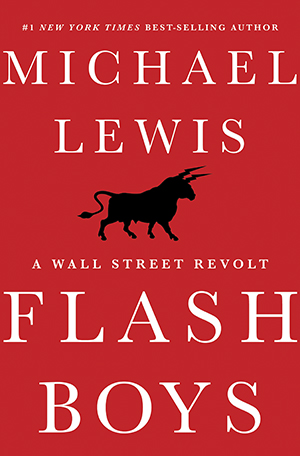‘Flash Boys’ in a nutshell
 The PR bluster around the new Michael Lewis book ‘Flash Boys’ is deliberately confusing, yet almost no-one seems to have read it. With the FBI investigating high-frequency trading (HFT), the issues that the book raises are clearly very serious. This is what you need to know.
The PR bluster around the new Michael Lewis book ‘Flash Boys’ is deliberately confusing, yet almost no-one seems to have read it. With the FBI investigating high-frequency trading (HFT), the issues that the book raises are clearly very serious. This is what you need to know.
1) HFT strategy is under the spotlight, specifically latency arbitrage. What is it?
Latency arbitrage takes advantage of the delay that other traders face in sending and receiving data and orders. An HFT firm using latency arbitrage gets data faster than other traders so it can tell what is being bought and sold at what price ahead of other traders. Secondly it trades faster than them – many thousands of times faster in some cases – so if you had to get to 30 different markets in order to buy 1,500,000 IBM shares, it would know you were trying to buy those shares, buy them ahead of you and raise the price by a fraction, say 0.5 cents.
2) Is this a US only problem?
The US model requires trades to be routed across all exchanges to find the best price, under Regulation NMS (Reg NMS). As an order is routed from one venue to another in a consistent route, at a consistent speed across a given network, from any given broker, arbitrageurs have a known window of opportunity to intercept a trade. Any market in which many trading venues exist could support the same model.
3) Why are brokers and infrastructure providers under attack?
They have all offered facilities that have supported latency arbitrageurs in their attempts to take money from the trades of fund managers. The book alleges that brokers have provided high-speed connections for their clients to move between markets faster than the brokers’ other clients. Trading venues have all offered ways for latency arbitrageurs (and other HFT firms) to get market data faster than other traders. The book notes that the cost of this high-speed data connection (US$10,000+ per month) requires an economic model that produces profit beyond the reach of a typical retail investor. The current round of investigations by US authorities is focussed on the similarity between sending data to one person faster than another, and giving data to one person before another. The latter is illegal. The New York Stock Exchange was fined US$5 million in 2012 on the basis that they are the same thing.
4) How do brokers win from HFT?
The book estimates that brokers take 15% of what HFT firms make, but also by routing order to lots of venues (brokers own 44 out of 45 alternative venues in the US, according to Ronan Ryan, chief strategy officer of exchange IEX) they avoid having to pay the main exchanges fees, capture order data themselves (which is very valuable) and do not lose control of liquidity. In the 2000s, brokers began to hold on to liquidity as much as possible, as the ongoing market fragmentation made execution harder to achieve.
5) The book is very much in favour of IEX; why?
IEX is an exchange based on the principal of confounding HFT strategies, simply by routing orders to other venues so that they all arrive at the same time, preventing any gaming. It has enjoyed enormous success since the book was published, according to chief strategy officer Ronan Ryan. However that says more about some buy-side firms than it does about IEX. It is far from being the only venue that is able to counter HFT.
6) Is the book biased in favour of Goldman Sachs?
Lewis writes that GS co-operated with him, but the firm is said to be every bit as involved as other brokers. While Lewis does note is that GS decides to stop engaging in HFT earlier than some brokers, because it lacked the technological flexibility to support it, he is critical of the prosecution of Sergey Aleynikov, a programmer who was wrongly convicted for stealing HFT system code from Goldman Sachs.
7) Should I read the book?
Yes! And don’t read any reviews until you have.
Source Finextra